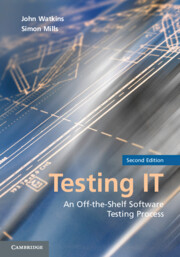Book contents
- Frontmatter
- Contents
- Foreword to the Second Edition by Geoff Thompson
- Foreword to the First Edition by Maurice Rosenburgh
- Acknowledgments
- 1 Introduction
- PART 1 THE TRADITIONAL TESTING PROCESS
- PART 2 THE TESTING PROCESS IN THE REAL WORLD: ILLUSTRATIVE CASE STUDIES
- PART 3 THE APPENDICES
- Appendix A Terms of Reference for Testing Staff
- Appendix B Testing Guides
- Appendix C Test Plan Document Template
- Appendix D Test Specification Document Template
- Appendix E Test Script Template
- Appendix F Test Result Record Form Template
- Appendix G Test Log Template
- Appendix H Test Certificate Template
- Appendix I Reuse Pack Checklist
- Appendix J Test Summary Report Template
- Appendix K Equivalence Partition Example
- Appendix L Boundary Value Analysis Example
- Appendix M State Transition Example
- Appendix N Pairwise Testing Example
- Appendix O Automated Testing Tool Selection Criteria
- Appendix P Usability Testing Overview
- Appendix Q Testing Process Health Check
- Appendix R The Testing of Object-Oriented Software
- Appendix S Pragmatic Test Process Adoption – a Real-World Example
- References
- Glossary
- Index
Appendix P - Usability Testing Overview
Published online by Cambridge University Press: 03 May 2011
- Frontmatter
- Contents
- Foreword to the Second Edition by Geoff Thompson
- Foreword to the First Edition by Maurice Rosenburgh
- Acknowledgments
- 1 Introduction
- PART 1 THE TRADITIONAL TESTING PROCESS
- PART 2 THE TESTING PROCESS IN THE REAL WORLD: ILLUSTRATIVE CASE STUDIES
- PART 3 THE APPENDICES
- Appendix A Terms of Reference for Testing Staff
- Appendix B Testing Guides
- Appendix C Test Plan Document Template
- Appendix D Test Specification Document Template
- Appendix E Test Script Template
- Appendix F Test Result Record Form Template
- Appendix G Test Log Template
- Appendix H Test Certificate Template
- Appendix I Reuse Pack Checklist
- Appendix J Test Summary Report Template
- Appendix K Equivalence Partition Example
- Appendix L Boundary Value Analysis Example
- Appendix M State Transition Example
- Appendix N Pairwise Testing Example
- Appendix O Automated Testing Tool Selection Criteria
- Appendix P Usability Testing Overview
- Appendix Q Testing Process Health Check
- Appendix R The Testing of Object-Oriented Software
- Appendix S Pragmatic Test Process Adoption – a Real-World Example
- References
- Glossary
- Index
Summary
Introduction
This appendix provides a brief overview of the process of usability testing. For a comprehensive treatment of this topic see (9).
Specifically, this appendix describes the roles and responsibilities, test design, test and post-test activities, and provides a graphical view of the organization of a typical usability test.
Roles and Responsibilities
The following roles are applicable to usability testing:
Test team leader – the usability testing project is managed on a day-to-day basis by the test team leader, who is also responsible for liaising with all other staff involved in testing
Test analyst – the usability testing scenarios are devised by the test analyst with reference to available usability requirements for the application under test (AUT) and in close collaboration with the development team leader. This collaboration is essential for identifying specific areas of concern within the AUT user interface (UI) that may need to be investigated
User representative(s) – Usability testing is conducted by a number of user representatives (users). For the purposes of obtaining accurate statistical results, the more users that can be persuaded to get involved, the better. As a general rule, ten users is the minimum number that should be involved in a testing project
Test observer – the testing is remotely monitored by a test observer, who monitors all sources of information from the test (video, audio, and captured AUT UI images) and who has computer-aided support for subsequent analysis of the information
Development team leader – the development team leader may optionally sit with the test observer to observe the test
[…]
- Type
- Chapter
- Information
- Testing ITAn Off-the-Shelf Software Testing Process, pp. 289 - 291Publisher: Cambridge University PressPrint publication year: 2010

